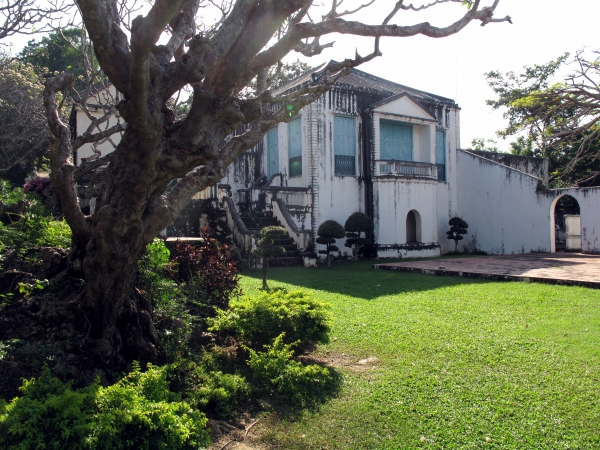
The upper-most buildings of the palace complex, as seen from the Chom Phet Pagoda. The circular structure immediately behind the flag is the observatory.
The palace built by King Mongkut was given the name Phra Nakhon Khiri, which means "celestial city on a hill". It was significantly expanded in the reign of his successor, King Chulalongkorn. The palace buildings are arranged along a meandering path up the hill towards the main buildings, which essentially comprise the inner court where only the King and his consorts were allowed.

Santakarn Sa-tan throne hall
The first buildings you will come to are the carriage houses and barracks for the palace guards. The first large residence you come to is the Santakarn Sa-tan throne hall, a large white building with blue trim set into the side of the hill. The large paved rectangular platform in front of the building was used for classical masked dance (khon) performances. The king would watch the performances from the balcony of the throne hall, while the courtiers would arrange themselves around the stage below. Later the building was used by the king's valets.
Further up the hill is the main residential complex. The main building is the Phetchaphum Phairot hall, which is now a museum. It was originally the throne hall of the complex, but was renovated in 1883 to accommodate the Duke of Brunswick during his visit to Siam. The king had been the guest of the Duke on his two visits to Europe. The rooms have been restored to the appearance they had during the Duke's stay. There is a formal dining room, a large reception room for entertaining and a bedroom as well as a large bathroom. Behind these halls and up stairs is the king's own private apartments, consisting of a study, bathroom and tiny bedroom.
You need to show your ticket to gain admission to the museum. You must remove your shoes and take them with you. No photography is allowed inside.
At the top of the hill is the Wetchaya Wichian Maha Prasat, and old style prang (pagoda) that served as the center of worship for the palace. To the west of this is a large hall that the king reportedly used to give sermons to the court. It now houses a photographic exhibit about King Mongkut as well as the current monarch and his family. The last structure in this group is a two story round observatory. King Mongkut was a keen astronomer, and back in the nineteenth century this would have been a very good place for stargazing.